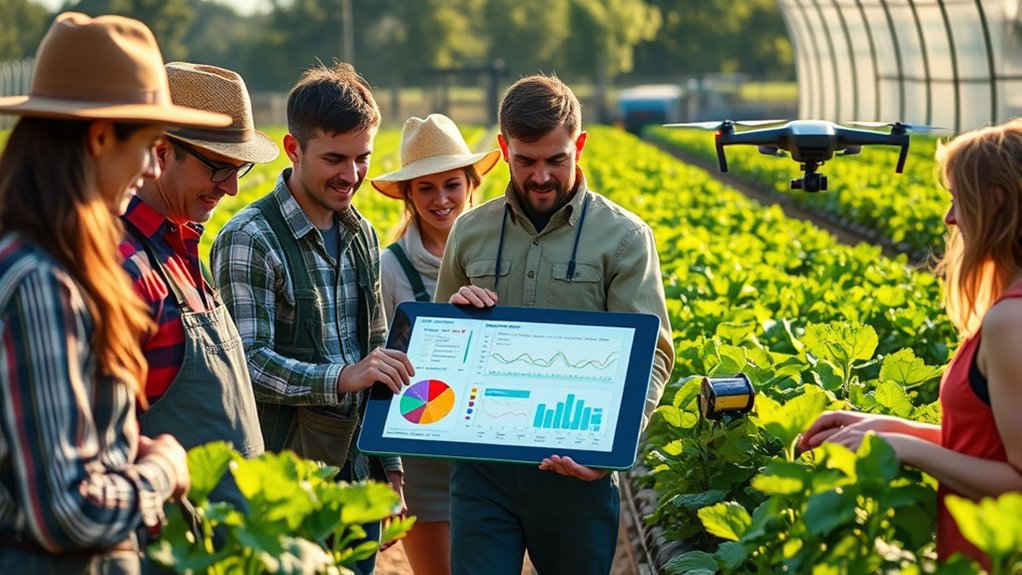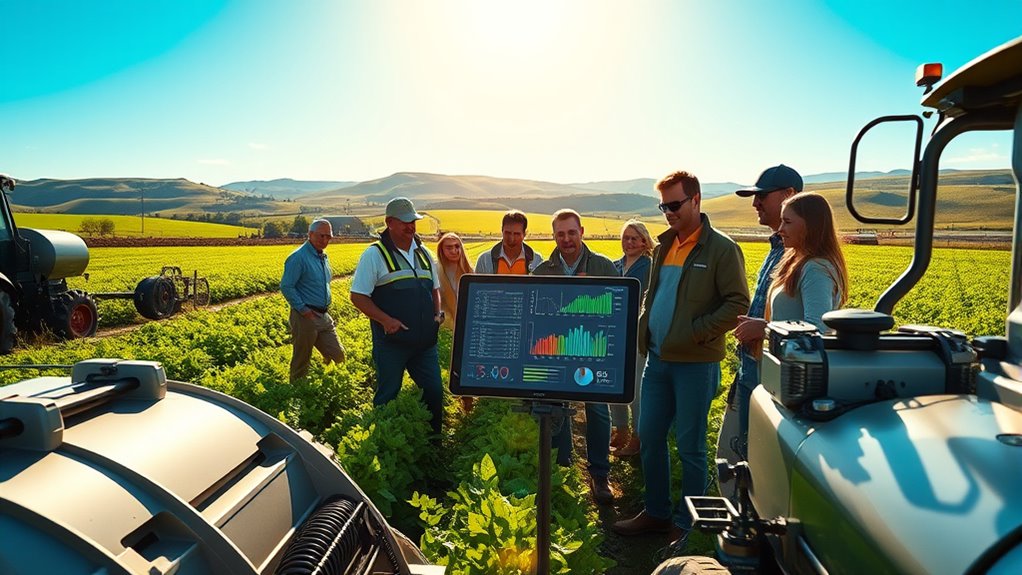Design thinking in agriculture puts you at the center of innovation by actively involving farmers, ensuring solutions are practical and tailored to real challenges. Your insights help develop tools and strategies that work best for local conditions, fostering trust and ownership. This iterative process promotes adaptable, sustainable farming practices that address environmental and market changes effectively. Keep exploring to discover how human-centered design is transforming farming into more resilient, efficient, and inclusive.
Key Takeaways
- Engaging farmers in co-creating solutions ensures innovations address real-world challenges and promote practical adoption.
- Iterative processes with continuous feedback refine tools and strategies, increasing their relevance and effectiveness.
- Human-centered design fosters trust, collaboration, and local knowledge integration, enhancing cultural appropriateness.
- Participatory approaches accelerate development, improve sustainability, and adapt solutions to environmental and social contexts.
- Modern farming benefits from tailored, inclusive innovations that boost efficiency, resilience, and sustainable practices.

Design thinking is transforming agriculture by encouraging innovative solutions that directly address farmers’ needs. This approach puts you at the center of the process, focusing on understanding your daily challenges and collaborating to find practical, effective answers. Instead of relying solely on traditional methods or top-down technology deployments, design thinking emphasizes farmer engagement, making you an active participant in shaping the tools and practices that impact your work. By involving you throughout the process, solutions are more tailored, feasible, and sustainable, leading to real change on the ground.
Design thinking centers farmers in innovation, creating practical, sustainable solutions tailored to your daily farming challenges.
When you’re engaged in the design process, your insights become invaluable. Farmers are the experts of their own land and equipment, and their firsthand experiences help identify pain points that might otherwise be overlooked. This engagement sparks innovative solutions that are rooted in reality, rather than assumptions. For example, through direct conversations and participatory workshops, you might highlight specific irrigation issues, pest management concerns, or storage challenges that need addressing. These insights guide developers and researchers to create tools and strategies that truly fit your context, increasing the likelihood of adoption and success.
Involving farmers in the innovation process also accelerates the development of practical solutions. When you provide feedback early and often, it helps refine ideas quickly, avoiding costly missteps. This iterative process encourages experimentation—trying out prototypes, observing how they work in your environment, and making adjustments until the solution meets your needs. Such continuous engagement fosters a sense of ownership, motivating you to adopt and champion new technologies or practices because you helped shape them from the start.
Furthermore, this co-creation approach builds trust between farmers and those developing new solutions. It breaks down the traditional gap where technology or advice is handed down from experts without your input. Instead, it creates a partnership, empowering you to contribute your knowledge and preferences. This collaboration ensures that innovations are not only technically sound but also culturally appropriate and economically viable, increasing their sustainability over time.
In essence, integrating farmer engagement into the design thinking process transforms agricultural innovation from a top-down effort into a participatory journey. It leads to more innovative solutions that address real needs and are more likely to be embraced by farmers like you. This human-centered approach helps modernize farming, making it more efficient, resilient, and adaptable to future challenges. By prioritizing your voice and experiences, design thinking paves the way for smarter, more inclusive agricultural development that benefits everyone involved. Emphasizing diversification and tailored solutions ensures resilience against market fluctuations and climate variability, ultimately supporting sustainable farming practices.
Frequently Asked Questions
How Does Design Thinking Address Environmental Sustainability in Agriculture?
You can see that design thinking promotes environmental sustainability in agriculture by focusing on regenerative practices and resource conservation. By empathizing with farmers and understanding ecological impacts, you develop innovative solutions that reduce waste and restore soil health. This approach encourages you to experiment with sustainable methods, optimize water use, and adopt eco-friendly technologies, ensuring farming practices become more resilient and environmentally responsible for future generations.
What Are the Main Challenges Farmers Face When Adopting Design Thinking?
You might face farmer skepticism, as only about 30% of farmers currently embrace new approaches like design thinking. Resource limitations also pose a big challenge, making it hard to invest in innovative solutions. You may worry about disrupting established routines or lack the necessary funds and knowledge. Overcoming these hurdles requires demonstrating clear benefits and providing support to build confidence and trust in adopting human-centered, creative strategies.
Can Design Thinking Improve Crop Yields Effectively?
Yes, design thinking can improve crop yields effectively. By focusing on crop diversification and soil health, you identify innovative solutions tailored to your farm’s unique needs. You’ll experiment with different crops and practices, analyze results, and refine strategies. This human-centered approach helps you develop sustainable methods, boosts productivity, and guarantees long-term farm resilience, making your crop yields more consistent and profitable.
How Do Technology and Human Insight Integrate in Agricultural Design?
You’re on the right track when you realize that technology and human insight go hand in hand in agricultural design. By collaborating closely with farmers, you access innovative solutions that blend cutting-edge tools with real-world experience. This synergy guarantees designs are practical and effective, turning the tide toward more sustainable, productive farming. Together, you bridge the gap between tech and tradition, proving that teamwork makes the dream work.
What Skills Are Essential for Farmers to Implement Design Thinking?
To implement design thinking, you need strong skills in innovative problem solving and stakeholder collaboration. You should be open-minded, adaptable, and willing to experiment with new ideas. Effective communication helps you understand farmers’ needs and work with diverse stakeholders. Cultivating empathy allows you to develop user-centered solutions. By honing these skills, you can create innovative farming practices that address real challenges and foster sustainable growth.
Conclusion
By adopting design thinking, you can revolutionize agriculture with fresh, human-centered solutions. Remember, over 70% of farmers worldwide report increased productivity after implementing innovative practices rooted in user insights. Embracing this approach helps you address real needs, foster sustainable growth, and stay ahead in a rapidly changing industry. So, don’t hesitate—apply design thinking today and transform farming into a more efficient, innovative, and resilient future.









